1. One Billion Trees Partnership project underway
In late April 2020 we received the exciting news that NZDFI has been awarded a grant of $539,000 from Te Uru Rākau’s One Billion Trees Partnership Fund. The funding will go towards work to accelerate the availability of our elite, genetically improved planting stock, with the focus on Eucalyptus bosistoana and E. globoidea.
Under this project NZDFI aims to produce 300,000 elite plants including: 100,000 E. bosistoana seedlings, 100,000 E. bosistoana clones and 100,000 E. globoidea seedlings. These seedlings and clones will be taken from the most elite families/trees identified from existing NZDFI trial sites.
There is already strong interest from landowners wanting to plant these improved trees, and all those who have supported our project will be given priority as the new nursery stocks becomes available.
We also plan to establish a series of new trials including new breeding populations, genetic gain trials and clonal trials in collaboration with our existing landowner hosts and new landowners with suitable sites who would like to actively participate in our research.
Please contact Paul Millen if you are interested in booking some of our improved planting stock in 2021 and/or to offer possible sites for NZDFI trials.
An early indication will be very helpful.
The plants will be launched under the ‘Xylogene’ brand ensuring that their genetics and quality are known, and the programme is recognised. The improved plants will be available for sale to landowners wishing to plant durable eucalypts from 2021 onwards.
A collection of open-pollinated seed of E.bosistoana and E.globoidea from breeding population trials in Marlborough and Wairarapa this autumn has yielded good quantities of seed from elite families. Another collection was made from the E.bosistoana clonal seed orchard managed by Proseed NZ at Amberley. These seedlots will be supplied to contracted nurseries that produce containerised seedlings, which will be made available to landowners ready for planting in 2021.
Multiplication of E.bosistoana stool plants is continuing at the Proseed propagation facility in preparation for setting cuttings in September. The production of clones from cuttings is supported by a research project at the University of Canterbury Botany Department where researchers are working to develop a tissue culture propagation system using the best genotypes of E.bosistoana. (Read more about the work going at Proseed later in this Project Update.)
Read our full media release here.
-
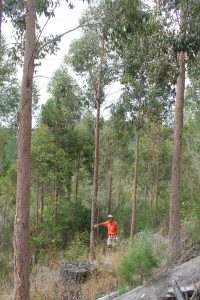
-
Paul Millen at a 10-year-old Wairarapa E globoidea breeding trial in Feb 2020.
-
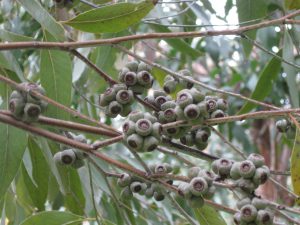
-
E. globoidea seed capsules.
-
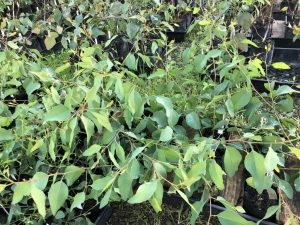
-
An E.bosistoana stool bed at Proseed, from which cuttings will be taken and set in September.
Contributor: Ruth McConnochie
⇑Top
2. Dr Steve Pawson joins the UC/NZDFI team
More good news – Dr Steve Pawson recently joined the University of Canterbury School of Forestry as a lecturer in Forest Health and Biosecurity. Steve will be carrying on the NZDFI-related research started by Dr Tara Murray. Initially Steve will be supervising Leslie Mann’s PhD work on assessing tolerance to paropsine browse. Further plans are afoot, however, with Steve already investigating options to support two more PhD projects. The first would examine the predators/parasitoids of the eucalypt variegated beetle and the second would look at landscape context effects on eucalyptus pest damage and the abundance of natural enemies.
Previously Steve was the Research Leader of Entomology in Scion’s Forest Protection group. Steve is a UC alumni having completed his PhD here in 2005 on the effects of
Pinus radiata forest management on beetle biodiversity. Since then he has been involved in many projects related to biodiversity and biosecurity as they apply to both directions across the border, i.e. imports and exports. Steve will be teaching foundation courses in biosecurity, forest biology, and insect biology to undergraduates.
⇑Top
3. Research Updates from UC/NZDFI Post-Grads
New PhD research on drying durable eucalypts
Vikash Ghildiyal has recently arrived from India to undertake a PhD supervised by Dr Clemens Altaner. He enrolled at the School of Forestry in April 2020, and his research topic is ‘Drying Durable Eucalyptus'. Vikash is funded by the University of Canterbury.
“I completed my Master's degree in Wood Science and Technology in 2019 at the Forest Research Institute (FRI) Dehradun, India. Prior to that, I got my Bachelor degree in Forestry (Honours) in 2017 at the College of Forestry, Veer Chandra Singh Garhwali Uttarakhand, India. My Masters dissertation was entitled "Effect of chemical pre-treatment on physical and mechanical properties of thermally modified wood”.
My research interest to date has mainly focused on quality enhancement of wood and finding appropriate technology for adding value to non-durable plantation timbers.
Utilising plantation-grown
Eucalyptus is often restricted to low-value pulpwood as drying of timber without defects is challenging. To allow their use for high-value solid wood products it is crucial to understand drying defects. Essentially, collapse and honeycomb are severe drying defects in eucalypts.
There will be three parts to my study:
- Investigating parameters contributing to collapse development in eucalyptus
- Reduce collapse in the current eucalyptus resources
- Reducing collapse in future eucalyptus resources.
The topic directly matches my research interest as I have a broad knowledge of wood science, particularly timber drying. I am lucky to be here and work in this professional environment surrounded by people full of passion, determination, and vision to build the sustainable hardwood industry based on eucalypt forests.”
⇑Top
Modelling stem properties for eucalypts
Daniel Boczniewicz
Daniel Boczniewicz is a fourth generation forester from Poland, whose PhD studies focus on modelling stem properties of durable eucalypts. Over the past year he has completed felling and analysis of the heartwood and sapwood of 74 E. globoidea trees from mature and semi mature stands in several regions.
My last six months have been divided between fieldwork and data analyses. In February 2020 I visited a 22-year-old
Eucalyptus globoidea stand near Tauranga and harvested 13 trees. This was my final fieldwork, and the data collected will contribute towards the first objective of my study – to develop taper and volume equations for
E. globoidea. In total I have sampled 74 trees from 8 different study plots around New Zealand, aged between 7 and 29 years.
Right now I am modelling taper and volume and so far I have managed to create non-linear system fit for compatible volume equations (five components – heartwood, sapwood, wood, bark, and total volume) using
Ordinary Least Squares method (OLS). I am creating wood and heartwood taper equations and they should be completed in the near future.
I am looking forward to solving the challenge of my second objective – determining the environmental factors that influence heartwood formation.
The images below illustrate some of the stages in my fieldwork, from the standing tree to the stained heartwood in cross-sections of each tree's stem.
-
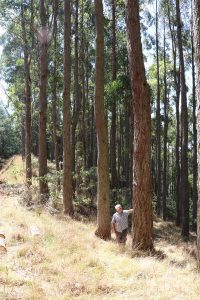
-
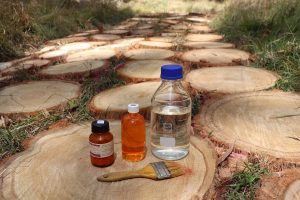
-
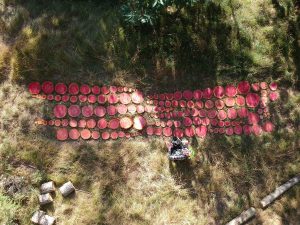
-
An aerial view of postgrad Daniel Bocniewicz’s E. globoidea fieldwork.
-
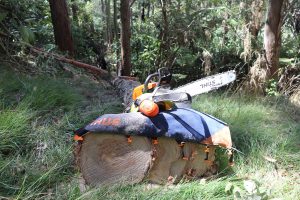
⇑Top
Wood Quality of Durable Eucalypts
Ebenezer Iyiola
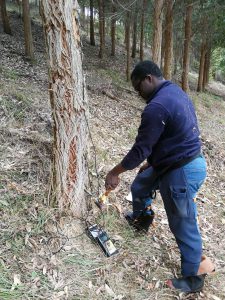
Measuring the acoustic velocity of an 8-year-old E. globoidea.
E. globoidea
wood properties including the genetic correlation between key traits, and optimising the sampling intensity of breeding trials. Sampling is one of the most resource intensive aspects of research into wood properties.
Over the past six months I have completed an analysis of acoustic velocity in
E. globoidea, and found that it is under moderate genetic control. Low genetic variation was observed in an 8-year old
E. globoidea breeding trial.
Together with the
previously reported information on heartwood properties (diameter and extractive content) and collapse, these results will now be incorporated as part of the NZDFI breeding programme to select improved genetics for mass propagation.
I am now finalizing my PhD thesis.
Essential oils of Eucalyptus bosistoana
Chamira Rajapaksha
Chamira Rajapaksha is from Sri Lanka, where she is a lecturer in the Department of Pharmaceuticals, University of Kelaniya. Chamira received a Sri Lankan scholarship to carry out her PhD at the University of Canterbury. She comes to the NZDFI with knowledge of natural compounds and the analytical techniques of extraction and identification of these compounds. Chamira’s work will contribute to assessing the potential for essential oils as a by-product of a durable hardwood industry. A second important aspect is to look for relationships between the oil content of leaves and levels of insect pest damage.
In March, just before the lockdown, I was able to collect leaf samples of
E. bosistoana with the support of my PhD colleagues Seoljong Kim and Ebenezer Iyiola, from the 2012 Dillon breeding trial to analyse genetic variation within and between families.
In total leaves from more than 2,000 trees comprising 85 families were sampled and oils extracted in the field using ethanol.
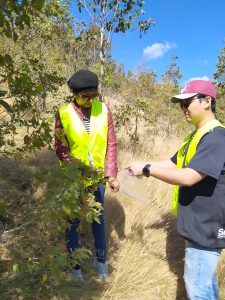
Chamira and Seoljong Kim working at Dillons trial site.
After lockdown, I was able to start analysing the chemical components in the eucalyptus essential oils by gas chromatography (GC). Currently I am analysing the results of gas chromatograms. Preliminary analysis suggests that most of the families yielded over 20 µl per gram of leaf and the most important component 1,8-cineole, which determines the oil quality, seems to exceed 70% of total oil in some families.
I have also been able to identify more compounds in leaf extracts from GC/mass spectrometry. I found d-limonene, terpeneol, p-cymene, α-pinene, β-pinene, trans-aromadendrene β- myrcene, trans-pinocarveol, iso-pinocarveol, ocemene and linalool.
I will evaluate the genetic variations using chromatographic data in upcoming months. I am also continuing research into annual variation of essential oil content and composition in
E. bosistoana leaves.
⇑Top
--------------------------------------------------------------------------------------------------------------------------------------------------------
Genomic and taxonomic study of Eucalyptus species
Seoljong Kim
Seoljong Kim is from South Korea. Seoljong’s PhD is a genomic and taxonomic study of Eucalyptus
species. One of his key research areas is to describe the differences between two closely related species, E. argophloia
and E. bosistoana
. Seoljong is collaborating with an international initiative to develop an improved version of a high‐throughput SNP (Single Nucleotide Polymorphism) genotyping system for eucalypts. This describes the genetic make-up of trees in great detail, and can be used to inform future genomic selection in breeding programmes.
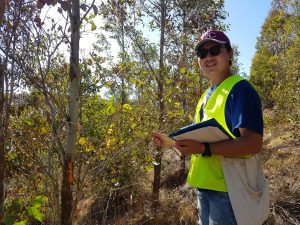
Seoljong collecting leaf samples in Marlborough.
In March I undertook fieldwork in Marlborough for two weeks. I collected leaf samples for DNA extraction and twigs for preparing herbarium specimens of
E. argophloia and
E. bosistoana from the Avery, Cravens, Dillon, and Lawson trials.
Samples from about 1200 trees were collected. Depending on the size of the leaves of each tree, around 2-5 leaves per tree were collected in the field and immediately placed into a plastic bag labelled with the trial, block, tree, and family numbers. The samples were stored in a freezer at the School of Biological Sciences at UC during the COVID 19 lockdown. The herbarium specimens were pressed and stored in a dry area during the trip and put into the drier at the University of Canterbury Herbarium (CANU) for about four days for complete desiccation.
Now I am continuing with DNA extraction in the laboratory. So far, I have attempted more than 600 extractions, and have achieved around 500 good quality DNA samples. Up to 400 samples are ready to be genotyped in the next few weeks.
⇑Top
Eucalypt health
Leslie Mann
Leslie Mann from Switzerland is researching eucalyptus defoliation by Paropsine beetles including Paropsis Charybdis
and Paropsisterna cloelia
(Eucalypt Variegated Beetle, EVB). One of her research areas will be in the use of aerial imagery to monitor and assess pest defoliation, as well as looking into the heritability and site effects of pest tolerance.
Earlier this year I assessed paropsine resistance by measuring leaf defoliation in four different types of trials:
- two demonstration trial sites (seven species), age 10 and 7 years
- E. bosistoana breeding trial age 8 years
- E. bosistoana clonal breeding trial age 2
- E. tricarpa breeding trial age 3.
Of the three techniques available to assess insect damage - tree grading, pest counting, and CDI (Crown Damage Index) methods, I found CDI the most efficient. With this technique, I take three shoots per tree and assess the incidence of the damage and multiply this by the severity of the damage, divide by 100 and this gives a health score. If the health score is low, the tree is lightly defoliated. If the health score is high, the tree is highly defoliated.
CDI remains a time demanding, qualitative technique. Identifying a rapid, quantitative method to assess insect defoliation could be a worthwhile NZDFI project.
In the demonstration trials, my results confirm that
E. macrorhyncha,
E. cladocalyx, and
E. globoidea are more resistant compared to
E. bosistoana,
E. tricarpa,
E. quandrangulata and
E. camaldulensis . This is the case in both the North and South Islands, and reinforces earlier NZDFI research.
E. tricarpa was the most defoliated species and there was no site effect. In the breeding trials, I confirmed that, with
E. bosistoana and
E. tricarpa, variability exists between families of the same species.
All
E. tricarpa families in the breeding trial were also highly defoliated, confirming the results obtained in the demonstration trial. In the case of
E. bosistoana, there was variation in defoliation between and within families in the breeding trial
.
We assessed
E. bosistoana clones individually using the pest counting method because the trees were not yet defoliated. There were many inter-family variations, and the method proved inconsistent in terms of defining the mean of eggs, larvae, or adults counted within the same family.
-
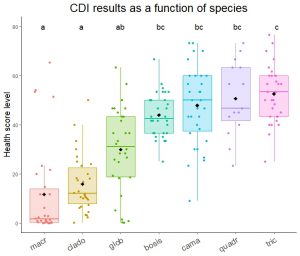
-
Comparative health score of different species (CDI technique).
-
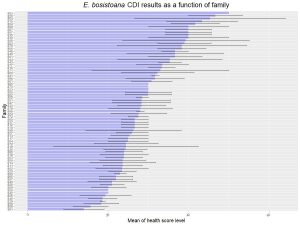
-
Health score variation between different E.bosistoana families.
My next steps are to assess:
- variation in resistance between provenances of E. bosistoana to see if this is due to family or provenance
- tolerance in our different trials during summer 2020/21
- tolerance of different Eucalyptus species in a greenhouse with controlled biotic and abiotic factors
- analysis of resistance using LiDAR technology (initial test).
⇑Top
4. Winner of the NZIF Future Forests Scholarship
Leslie has recently been awarded the prestigious NZ Institute of Forestry 2020 Future Forests Scholarship.
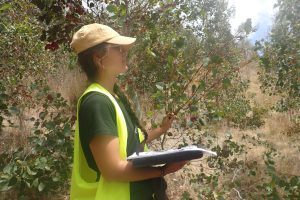
Leslie assessing defoliation of a tree shoot.
"I am very happy to have been awarded this scholarship. The funds will help finance a foliar analysis of my greenhouse trees. I will measure insect tolerance against DBH, height, new shoot length and photosynthetic rate, but I will also analyse leaf chemical compounds.
Eucalyptus herbivory resistance could be due to different concentrations of sideroxylonal (formylated phloroglucinol) compounds. Tree tolerance could also be related to nitrogen and non-structural carbohydrate stocks."
⇑Top
5. Proseed propagation update
Contributor: Paul Schroeder
Proseed is making progress with seed orchard establishment. First seed collections have been completed and work on propagation of cuttings from superior clones is continuing.
New E.bosistoana selections
Grafting scions were collected late February from a set of nine new E bosistoana selections in the Ngaumu breeding trial. All clones were captured with 6 or more ramets of each clone, a good result given that the Ngaumu site was experiencing severe drought during scion collection. Along with a similar set of 17 clones from Cravens Road, collected the previous summer, there are about 330 ramets available to complete the Amberley clonal orchard and to also replace about half of the original clones, now shown to have weaker breeding values.
Pest control
Last summer we took action to prevent a repeat of the damage done to the
E. bosistoana seed crop by eucalypt leafroller (
Strepsicrates macropetana).
At the start of flowering two pheromone traps were placed to monitor pest activity. Lures are species specific and none is available for eucalypt leafroller, so one trap was set with a codling moth lure and one with an oriental fruit moth lure, both species being in the same tortricidae subfamily as eucalypt leafroller. During the ensuing 2-month flowering season a couple of codling moths were captured but no eucalypt leafroller. Eucalypt leafroller is active in Amberley orchard so it is assumed the lures used were ineffective.
Fortnightly spraying with Delfin BTK (a bacterial insect gut pathogen) seems enough to prevent eucalypt leafroller establishing and there was no need to follow through with either a multi-inhibitor (to disrupt larval moulting) or any pesticide, which is a very good result for bees pollinating the crop! We are now looking forward to a good seed crop next summer.
E. bosistoana seed collection
Despite the damage caused by leafroller last season, seed was available for collection. Capsules were gathered from thirteen of the fifteen clones in the orchard and close to 100 gm of seed and duff was extracted. Another 400 gm of seed and duff was collected from another seedling seed orchard planted with surplus stock from early breeding trial establishment. Testing of cleaned seed from the largest clonal lot showed 99% germination and 1,792 germinants/gm while cleaned seed from the seedling seed orchard showed 100% germination and 2,252 germinants/gm.
Improvements to the propagation unit
Work honing the cutting technique continues. Shade screens have been installed which we expect will improve cutting strikes next summer.
Hydroponic stools
A pilot hydroponic stool facility was constructed last summer and is functioning well. Proseed is working with suppliers to develop a nutrient mix that will produce good growth without some deficiencies that occurred in an earlier setup using standard nutrient formulas.
Alternative rooting media
A proprietary sand, pumice and peat rooting media was trialed as an alternative to the peat perlite mix copied from Australian practice. The new media proved clearly superior: 82% strike vs 67% in the current mix, plus, the root quality was better and the mix did not irritate breathing the way perlite does.
Cuttings from aged material
A collection of coppice growth from felled E. bosistoana in the Cravens Road breeding trial was organized to check for any age effect on strike rate. Unfortunately, only four of thirty-three stumps produced coppice worth collecting, likely due to shallow flooding of the trial area for several days by the Wairau river following felling. The better two clones struck at 32% and 53%. That compares to an average of 47% for 27 Woodville selections propagated the previous autumn and 67% for one-year old material set as an experimental control. Flimsy data but it does seem cutting propagation is still a go at age 10 years and there are still techniques like serial propagation that can be called on.
Commercial distribution of rooted cuttings
Scaling up
E bosistoana stool plants is proving problematic, mainly due to the difficulty achieving consistently high rooting strikes across all selected clones. Proseed has begun working with the University of Canterbury Botany Department tissue culture laboratory to accelerate multiplication of stool material. Progress with propagation of selections from the Woodville
E quadrangulata stiffness trial is going well.
-
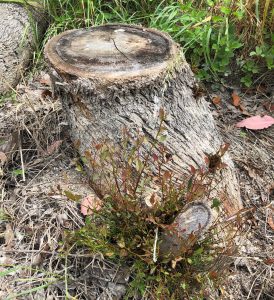
-
Early coppice growth from a stump in the Cravens Road breeding trial.
-
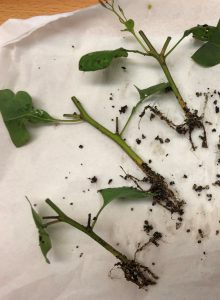
-
Newly rooted cuttings set in sand:pumice:peat media.
-
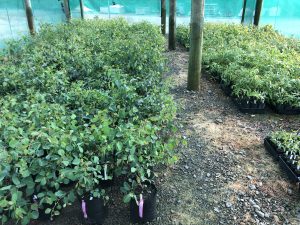
-
Potted stool plants raised two summers ago.
-
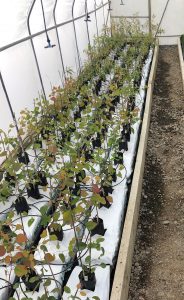
-
E bosistoana and E quadrangulata stools growing in a hydroponic system.
⇑Top
6. Posts, posts, posts
Posts are likely to be one of the key early markets for our durable timbers, so the better we understand and can quantify this potential market the better.
Dr Clemens Altaner recently authored a report reviewing national and international production, markets, and production techniques for wooden posts, and the future potential for durable timber posts in New Zealand. The report includes an initial economic analysis of post wood production from NZDFI elite
E. bosistoana.
The report is available on the Specialty Wood Products Research Partnership (SWP) website.
- Evaluation of post recovery from E. bosistoana
To obtain the data required for Clemens' economic analysis mentioned above, trees in the NZDFI 2009 and 2010 Cravens Road breeding trials were evaluated using conventional forest inventory techniques and cutting plans. The aim was partly to demonstrate and quantify the predicted improvement in yield from the best-performing ‘elite’ E. bosistoana families, and also from exceptional trees that are not in the best performing families. The predicted post yield was analysed against known breeding values for other characteristics to create a family ranking (see Table 1). The analysis showed that data collected and analysed from these breeding populations are successfully selecting germplasm with improved traits for product recovery.
- Assessing the market for posts in NZ’s agricultural and horticultural industries
Honours student Boris van Bruchem is analysing the treated wood market for agricultural and horticultural uses in New Zealand for his dissertation. In this case, ‘treated wood’ refers to fence posts for stock and crops, kiwifruit pergolas and vineyard posts; also possibly orchard crops. Boris is using various ways to gather data, including surveys of fence post manufacturers and timber treatment plants to ascertain levels of production, and surveys of the forest growers known to be supplying material to manufacturers. Boris’s
completed dissertation is now available.
⇑Top
7. Hawke's Bay report on portable sawmilling and alternative timbers
Recently Paul Millen wrote a report for Hawke’s Bay Regional Council and Hawke’s Bay Regional Investment Company Ltd:
Report on portable sawmilling of alternative species timbers- a sustainable small-scale regional industry
The report includes an assessment of the scale of the existing resource of small plantations and woodlots of alternative species in the Hawkes Bay region as these forests could provide the foundation of a sustainable supply for small scale or mobile sawmilling. It also examines the types of small-scale sawmills in use in New Zealand and how their increased use, combined with small-scale harvesting, could produce an increasing sustainable supply of locally grown timbers that could substitute imported timbers. In addition, the report reviews current alternative species value chains, and proposes a new industry association for small-scale sawmillers.
The report has led to two work plans being approved, to be funded by Forest Growers Research (Specialty Wood Products Research Partnership, SWP):
- a project to encourage regional development of New Zealand’s alternative timbers sector, and
- a project in Hawke’s Bay Region (part-funded by the Hawke’s Bay Regional Council) to develop a new forest inventory of alternative species forests based on quality mapping and data.
The work in these two projects is a step in the right direction for all durable eucalypt growers, because they acknowledges both the need for an accurate inventory of the alternative species resource, and also the critical need for stronger regional value chains for alternative timbers.
(Images of portable sawmills taken from the Hawke's Bay report)
⇑Top
------------------------------------------------------------------------------------------------------------------------------------------------------------------------------------------------------------------------
8. Final word from Paul
I was delighted to finally send you all news of our Te Uru Rākau One Billion Trees Partnership grant in April. The money is a huge boost to our programme and another step towards our long-term vision. Reaching the point where we could announce the grant took a great deal of time and effort, and as ever, I am grateful to all members of the NZDFI team who contributed.
As described in this Project Update, work on the 1BT project is already well underway at Proseed to produce our first generation of elite planting stock under the ‘Xylogene’ brand. Please do get in touch with me as soon as possible if you think you may want some of the first nursery stock for next year’s planting season!
I would like to welcome Dr Steve Pawson to NZDFI’s Science team. We are very lucky to have someone with Steve’s expertise, energy and enthusiasm on board and we look forward to strengthening our research in the critical area of eucalypt health. Also it is very pleasing that, for the second year in a row and following in Daniel Boczniewicz’s footsteps, Leslie Mann, a NZDFI postgrad, has been awarded the NZIF scholarship. And welcome also to our newest postgrad, Vikash Ghildiyalhas, another impressive addition to our international cohort of young researchers. We can look forward to Vikash’s new research in the area of drying durable eucalypts.
Over the coming years we anticipate that many more New Zealand landowners will be looking for alternatives to radiata pine when considering trees as a possible land-use diversification. As the availability of our elite planting material increases, so we must ensure that good practical information is available for growers. Our aim is that all growers can successfully establish durable eucalypts and understand the various potential markets and end uses of the durable timber they are growing. To this end we will be working on new extension resources for the NZDFI website over the second half of the year.
⇑Top
Want to receive future Project Updates?
If you do not already receive our regular Project Updates, you can sign up here.
For more information about any of the work of the NZDFI, contact: info@nzdfi.org.nz





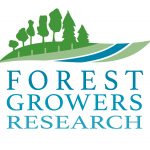

 “I completed my Master's degree in Wood Science and Technology in 2019 at the Forest Research Institute (FRI) Dehradun, India. Prior to that, I got my Bachelor degree in Forestry (Honours) in 2017 at the College of Forestry, Veer Chandra Singh Garhwali Uttarakhand, India. My Masters dissertation was entitled "Effect of chemical pre-treatment on physical and mechanical properties of thermally modified wood”.
My research interest to date has mainly focused on quality enhancement of wood and finding appropriate technology for adding value to non-durable plantation timbers.
Utilising plantation-grown Eucalyptus is often restricted to low-value pulpwood as drying of timber without defects is challenging. To allow their use for high-value solid wood products it is crucial to understand drying defects. Essentially, collapse and honeycomb are severe drying defects in eucalypts.
There will be three parts to my study:
“I completed my Master's degree in Wood Science and Technology in 2019 at the Forest Research Institute (FRI) Dehradun, India. Prior to that, I got my Bachelor degree in Forestry (Honours) in 2017 at the College of Forestry, Veer Chandra Singh Garhwali Uttarakhand, India. My Masters dissertation was entitled "Effect of chemical pre-treatment on physical and mechanical properties of thermally modified wood”.
My research interest to date has mainly focused on quality enhancement of wood and finding appropriate technology for adding value to non-durable plantation timbers.
Utilising plantation-grown Eucalyptus is often restricted to low-value pulpwood as drying of timber without defects is challenging. To allow their use for high-value solid wood products it is crucial to understand drying defects. Essentially, collapse and honeycomb are severe drying defects in eucalypts.
There will be three parts to my study: